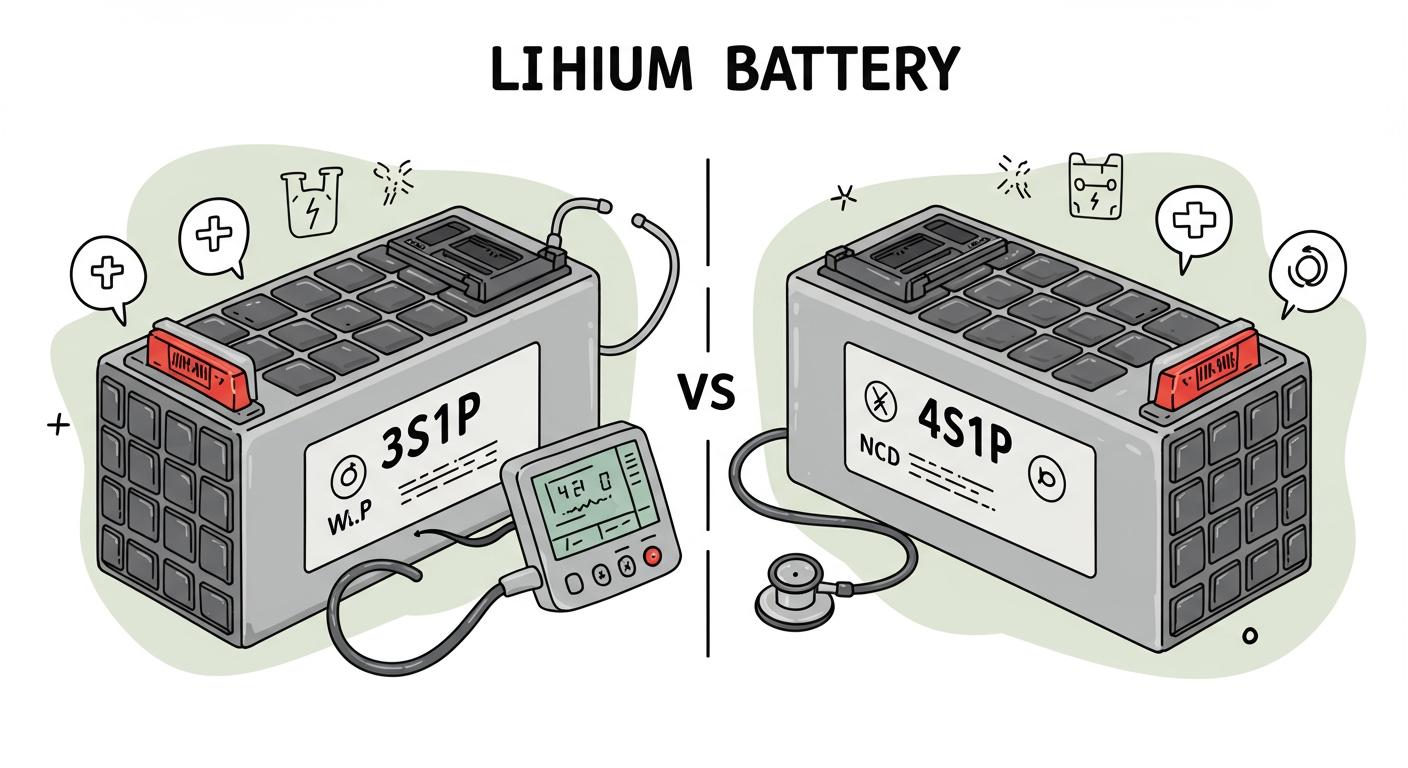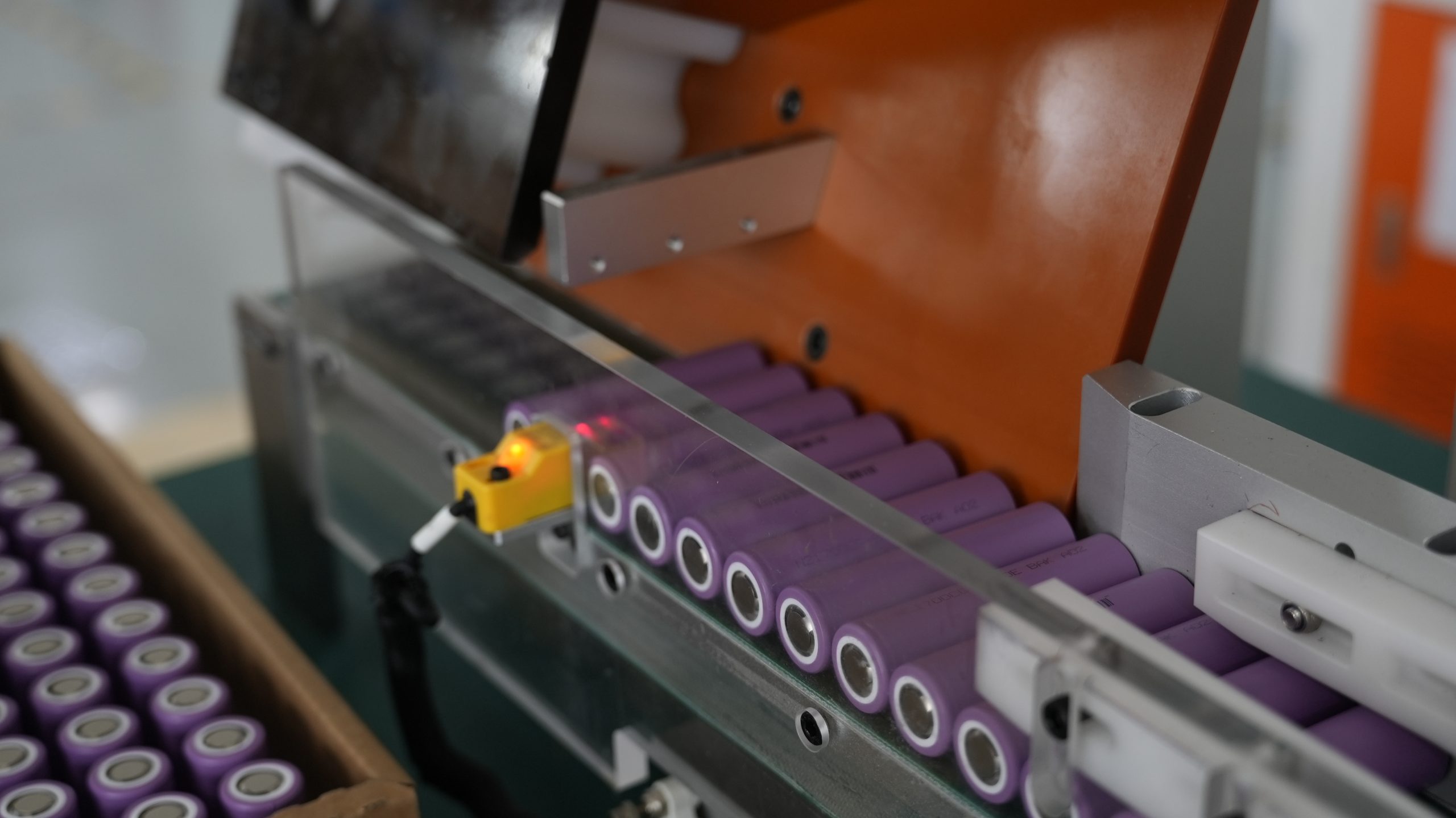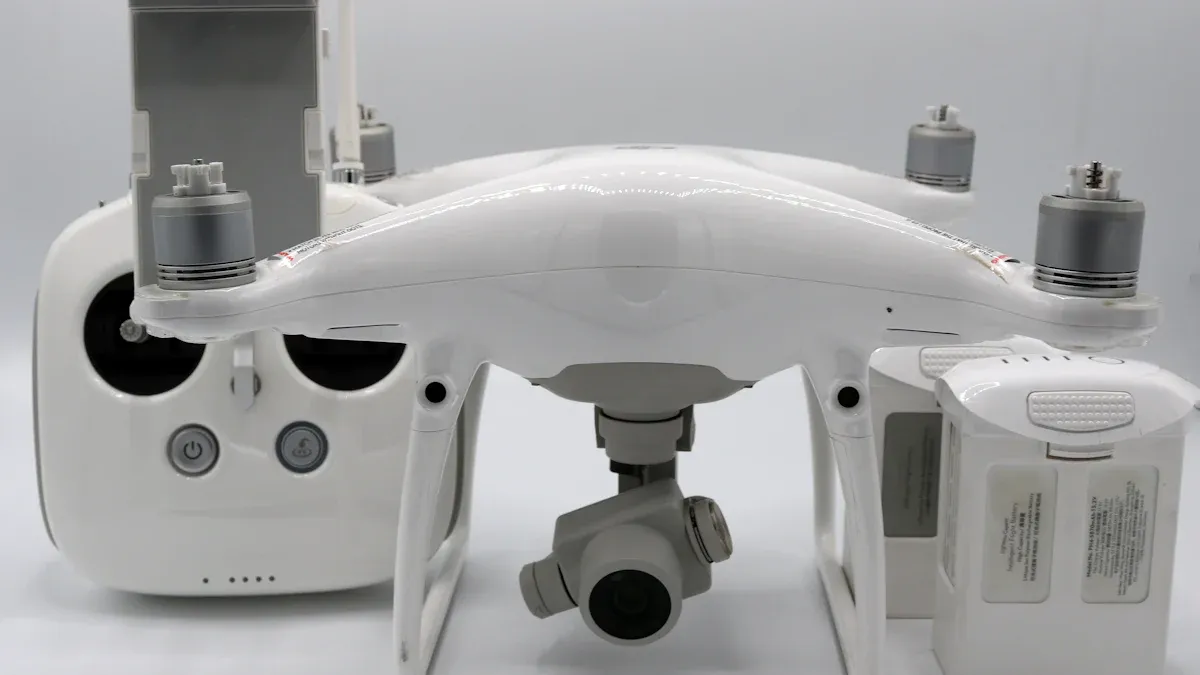
When you compare 3S1P vs. 4S1P lithium battery packs, you notice a clear voltage difference that affects your medical device‘s design and function. The table below shows standard voltage outputs for each cell configuration:
Cell Configuration | Nominal Voltage (V) |
|---|---|
3S1P x18650 | 10.8 |
4S1P x18650 | 14.4 |
Choosing the right battery and cell configuration is critical. If you match the battery to your device requirements, you help protect patient safety and ensure reliable performance.
Matching battery configuration to device requirements improves safety and performance.
Regulatory compliance and quality control reduce battery failure risks.
Ongoing monitoring keeps the battery and device safe during use.
Cell configuration determines the voltage, power, and runtime your device receives. You must understand these factors, as they directly impact how your battery supports medical equipment in clinical environments.
Key Takeaways
Understand the voltage differences: 3S1P packs provide 11.1V, while 4S1P packs deliver 14.8V. Choose based on your device’s voltage needs.
Match battery capacity to device requirements. Higher capacity in 4S1P packs supports longer runtimes for power-hungry devices.
Consider size and weight when selecting battery packs. 3S1P packs are more compact, ideal for portable devices, while 4S1P packs offer higher power.
Prioritize safety features in battery packs. Both configurations include protections against overcharge and overheating, essential for medical applications.
Always verify compliance with medical standards. Ensure your battery meets safety regulations to protect patient safety and device reliability.
Part 1: Cell Configuration

1.1 3S1P vs. 4S1P
You encounter two common lithium battery pack configurations in medical devices: 3S1P and 4S1P. The letters “S” and “P” stand for “Series” and “Parallel.” In a series connection, you link battery cells end-to-end, positive to negative. This increases the total voltage of the battery pack, while the capacity remains the same as a single cell. In a parallel connection, you connect battery cells side-by-side, positive to positive and negative to negative. This keeps the voltage the same as one cell but increases the overall capacity.
In a 3S1P battery pack, you have three cells in series. This setup gives you a higher voltage than a single cell, but the capacity matches just one cell.
In a 4S1P battery pack, you use four cells in series. This configuration boosts the voltage even more, while the capacity still equals one cell.
Tip: If one cell fails in a series configuration, the entire battery pack can lose voltage and performance. Always monitor cell health in medical applications.
Configuration | Number of Cells | Connection Type | Voltage | Capacity |
|---|---|---|---|---|
3S1P | 3 | Series | Higher | Single cell |
4S1P | 4 | Series | Even higher | Single cell |
You can tailor battery packs to meet specific device needs by choosing the right series and parallel battery configurations. For example, connecting four 18650 cells of 3,400mAh in series yields a nominal voltage of 14.4V, while the capacity remains 3,400mAh.
1.2 Lipo Battery Structure
Lithium polymer (LiPo) battery packs use the same principles of series and parallel battery configurations. You can design a battery pack with cells in series to increase voltage or in parallel to boost capacity. Most medical devices require a precise voltage and runtime, so you must select the right configuration.
Series connections raise the voltage for devices that need more power.
Parallel connections increase the ampere-hour rating, which extends device runtime.
You can combine series and parallel connections to achieve both higher voltage and greater capacity. This flexibility lets you match battery packs to the exact requirements of medical equipment.
Note: Always verify the voltage and capacity ratings of your battery pack before integrating it into a medical device. Proper configuration ensures safety and reliability.
Part 2: Key Differences
2.1 Voltage Output
When you compare 3s1p vs. 4s1p battery packs, voltage stands out as a primary difference. The 3s1p battery delivers a nominal voltage of 11.1V, while the 4s1p battery provides 14.8V. This difference in voltage directly affects device compatibility and performance. Medical devices often require specific voltage ranges to operate safely and efficiently. You will find that most medical equipment using lithium battery packs falls within a voltage range of 3.7V to 60V DC. Selecting the correct voltage ensures your device receives stable power and maintains optimal performance.
2.2 Capacity & Runtime
Capacity and runtime are critical when you evaluate 3s1p vs. 4s1p battery packs. Capacity, measured in ampere-hours (Ah) or milliampere-hours (mah), determines how long your device can run before needing a recharge. In both configurations, the capacity depends on the individual cell’s rating. For example, a 3s1p battery with 2.2Ah capacity and a 4s1p battery with 2.5Ah capacity will offer different runtimes. Higher voltage in the 4s1p battery can support devices with greater power demands, but the actual runtime also depends on the device’s discharge rate and battery capacity. You must match the battery capacity and voltage to your device’s requirements to ensure reliable performance.
2.3 Size & Weight
Size and weight play a significant role in portable medical devices. The 3s1p vs. 4s1p comparison shows clear differences in physical dimensions:
Battery Type | Nominal Voltage | Nominal Capacity | Dimensions (mm) |
|---|---|---|---|
3S1P | 11.1V | 2.2Ah | 2176.6122.7 |
4S1P | 14.8V | 2.5Ah | 16049.630.6 |
You need to consider these factors when designing compact or handheld equipment. The 4s1p battery may offer higher voltage and capacity, but it often requires more space. Always balance size, weight, and battery performance to meet your device’s needs.
2.4 Safety
Safety remains a top priority in medical battery applications. Both 3s1p and 4s1p battery packs integrate advanced safety features to protect against overcharge, deep discharge, and overheating. These features include:
Safety Feature | Description |
|---|---|
CUV (Cell Under Voltage) | Protection against deep discharge |
COV (Cell Over Voltage) | Protection against overcharge |
OTC (Over Temperature in Charge) | Protection against overheating while charging |
OTD (Over Temperature in Discharge) | Protection against overheating during discharging |
Battery Life Management | Protection against rapid cell aging |
You should always verify that your battery supplier follows responsible sourcing practices. For more information, review the conflict minerals statement. Battery management systems (BMS) also play a crucial role in maintaining safety and performance. Learn more about BMS here. Proper safety features and management systems help you reduce risks and maintain compliance in medical environments.
Part 3: Applications

3.1 3S1P Applications
You often see 3S1P lithium battery packs in medical devices that require moderate voltage and compact size. These battery packs deliver reliable power for portable equipment. The high energy density and lightweight design make them easy to integrate into devices where space is limited. You benefit from long cycle life and advanced safety features, which are essential for medical environments.
Feature | Description |
|---|---|
High Energy Density | Lightweight and compact design for easy integration. |
Long Cycle Life | Built with premium Li-ion cells for extended durability. |
Safety Features | Includes overcharge, over-discharge, and short-circuit protection. |
Wide Operating Temperature Range | Suitable for various environments. |
Typical applications for 3S1P battery packs include:
Infusion pumps
Portable patient monitors
Handheld diagnostic tools
Security scanners
You can rely on these battery packs for consistent performance in both clinical and field settings.
3.2 4S1P Applications
4S1P lithium battery packs support devices that demand higher voltage and longer runtime. You find these battery packs in advanced medical equipment, industrial robotics, and IoT systems. The 14.8V output and higher capacity meet the needs of power-hungry devices.
Capacity Range | Common Applications |
|---|---|
4.5–5Ah | Portable medical equipment, small monitoring devices, IoT systems |
You may use 4S1P battery packs in:
Portable medical equipment
Industrial and robotic applications
Infrastructure monitoring devices
These battery packs often power devices that require 14.4V or 14.8V and capacities up to 14,000mAh or 3,500mAh. You ensure stable operation for critical applications by selecting the right battery configuration.
3.3 Selection Guide
You must match the battery configuration to your device’s voltage and power requirements. Start by reviewing your device’s specifications. Consider the following steps:
Identify the required voltage and capacity.
Assess the physical space available for the battery.
Confirm that the battery meets safety and regulatory standards, such as ANSI/AAMI ES 60601-1, IEC 62133, and UL 1642.
Ensure the battery includes a reliable battery management system. Learn more about BMS.
Prevent the use of unapproved batteries and chargers to reduce risks.
Tip: Always choose battery packs from suppliers who follow industry standards and provide documentation for compliance.
You improve device reliability and patient safety by selecting the correct battery for your applications.
Part 4: Summary Table
4.1 3S1P vs. 4S1P Comparison
You need a clear reference when selecting the right battery pack for your medical device. The table below compares 3S1P and 4S1P lithium battery packs across key parameters. This comparison helps you evaluate which battery pack aligns with your device’s voltage, capacity, and safety requirements.
Parameter | 3S1P Battery Pack | 4S1P Battery Pack |
|---|---|---|
Nominal Voltage | 11.1V (Li-ion/LiPo) | 14.8V (Li-ion/LiPo) |
Typical Capacity | 2.2Ah – 3.4Ah | 2.5Ah – 3.5Ah |
Size (mm) | 21 × 76.6 × 122.7 | 160 × 49.6 × 30.6 |
Weight | Lower, supports compact devices | Higher, supports larger devices |
Safety Features | Overcharge, over-discharge, short-circuit, battery management system | Overcharge, over-discharge, short-circuit, battery management system |
Common Applications | Infusion pumps, portable monitors, handheld diagnostics | Portable medical equipment, industrial robotics, infrastructure monitoring |
Battery Chemistry | Lithium-ion, Lithium-polymer | Lithium-ion, Lithium-polymer |
Cycle Life | 500–1000 cycles | 500–1000 cycles |
Note: Both battery pack types require robust battery management to ensure safety and compliance with medical standards.
4.2 Application Overview
When you review application overviews, you gain essential insights for battery pack selection in medical devices. These overviews provide you with critical information about use cases, electronic architecture, and available battery pack options. You can evaluate the required battery energy, peak current, and the best battery chemistry for your application. This process ensures your battery pack meets operational and safety requirements.
Application overviews help you compare cell size, cost, availability, and safety certifications for each battery pack.
You can collaborate with your engineering team to review design concepts when multiple battery pack solutions are possible.
A comprehensive overview supports your decision-making, ensuring the battery pack you select aligns with your device’s needs and regulatory standards.
Tip: Always include battery management considerations in your evaluation to maintain safety and extend the life of your battery pack.
You see clear differences between 3S1P and 4S1P medical lithium battery packs. The 3S1P configuration gives you moderate voltage and compact size, while the 4S1P configuration delivers higher voltage for devices with greater power needs. You must match battery output voltage to your device’s requirements, using careful voltage regulation and selecting the right lithium chemistry.
Safety and compliance matter most. You need to follow standards like IEC 60601 and ANSI/AAMI HA60601-1-11. Risks include leaks, fumes, and blasts. Smart battery features, thermal management, and protection systems help you prevent failures.
Standard | Description |
|---|---|
IEC 60601 | Safety and performance for medical electrical equipment |
IEC 60601-1 | General safety requirements |
ANSI/AAMI HA60601-1-11 | Home use collateral standard |
You improve reliability and patient safety by choosing the correct lithium-ion or lithium-polymer battery pack. Always use a lipo battery guide and learn how to choose a lipo battery for your application. You also need to know how to maintain the lipo battery for long cycle life.
FAQ
What is the main difference between a 3S1P and a 4S1P lithium battery pack?
You get different nominal voltages. A 3S1P pack provides 11.1V, while a 4S1P pack delivers 14.8V. Both use series connections to increase voltage, but the number of cells in series changes the output.
How does cell configuration affect medical device performance?
You must match the series and parallel arrangement to your device’s voltage and runtime needs. Series increases voltage, parallel increases capacity. Proper configuration ensures stable energy delivery, reliable charge cycles, and optimal protection for sensitive equipment.
Why is a battery management system important in medical lithium battery packs?
You need a battery management system for protection. It monitors charge, discharge, and temperature. This system prevents overcharge, deep discharge, and overheating, which helps maintain safety and extends cycle life in demanding environments.
Can I use a lipo battery designed for a drone in a medical device?
You should not use a lipo battery made for a drone in medical equipment. Medical devices require strict protection, stable energy output, and certified chemistries. Always select battery packs that meet medical standards and regulatory requirements.
How do I select the right lithium battery chemistry for my application?
You should review your device’s voltage, energy density, and cycle life requirements. Lithium-ion and lithium-polymer chemistries offer different advantages. Consult technical data and industry standards to ensure the chemistry matches your application’s safety and performance needs.




